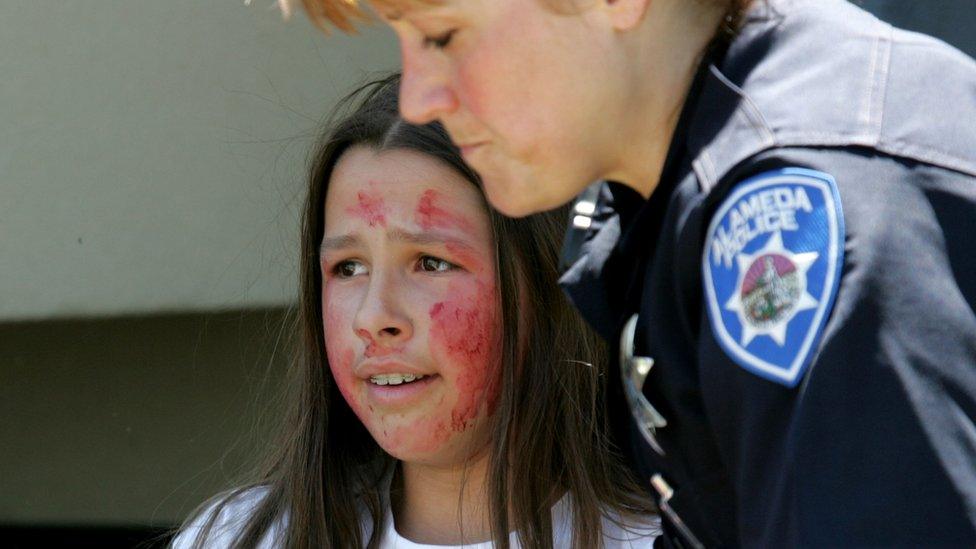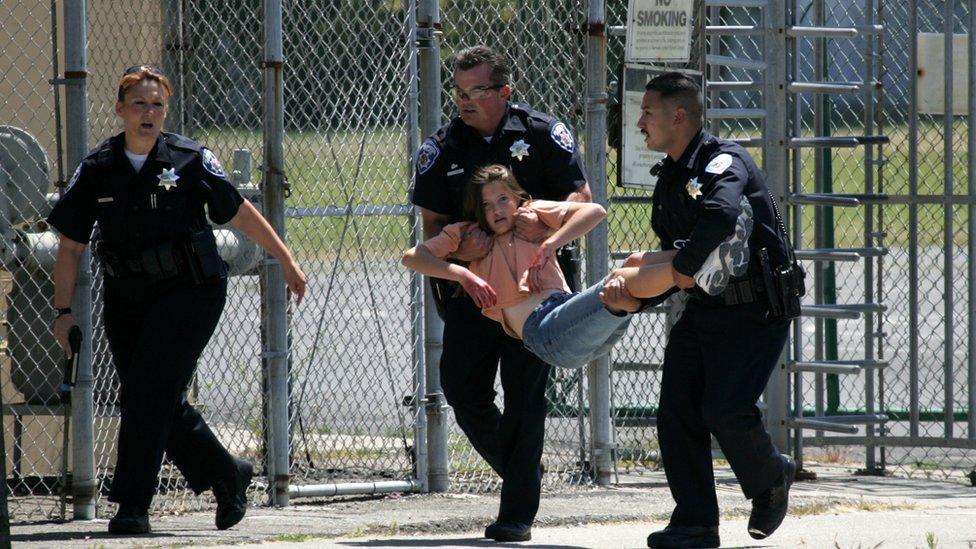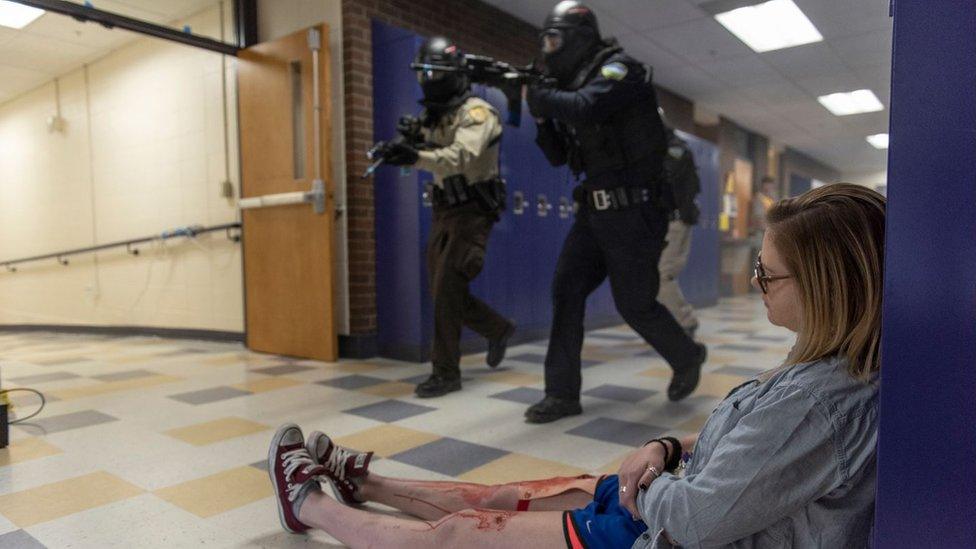US school shootings: Have drills gone too far?
- Published

A police officer tends to a student volunteer acting as victims during an active-shooter drill
A school in Indiana has been criticised for apparently shooting teachers "execution style" with pellets as part of an "active-shooter drill". The case has reignited conversations about the usefulness of drills and the methods used to prepare schools for shootings.
Active-shooter drills were first introduced into US schools after the Columbine High School massacre in 1999, and have been a common part of school life for a generation of Americans.
While 32 states have laws requiring some form of drill to protect students from intruders, the types of drills carried out varies widely between school districts.
An increasing number of schools are opting to conduct more intense drills involving masked men carrying fake guns and students playing the role of victims covered in fake blood.
But what are the implications of this approach to preparing educators and students for an active-shooter and does it work?

Many experts agree that discussing and practising how to respond to a dangerous situation, external will help protect students who find themselves faced with the real thing. Fire drills, for example, are well established tools to teach children how to behave in a potentially life-threatening situation.
David Schonfeld is the director of the National Centre for School Crisis and Bereavement and has worked with students and teachers who have experienced school shootings, including survivors of the 2018 Parkland attack.
While he believes that while drills can be helpful in preparing students and staff to take steps to protect themselves, he insists that drills must be tailored for their participants.
"A lot of drills are for adults - school professionals or law enforcement - to see how they react in situations," Mr Schonfeld told the BBC.
While more realistic and stressful situations may be appropriate here, he says "large-scale, prolonged, realistic drills are not ideal" for children.
"Students should always know it is a drill, be given concrete actions to take - such as hiding, turning off the lights and staying quiet for a few minutes - and be given lots of opportunity to practise.
"Children being asked to pose as victims on the floor covered in fake blood is just pointless and can be traumatising, I can't see why that's necessary."

Police officers carry a student volunteer during a drill
Mr Schonfeld is highly critical of what he terms "deception" drills, where students and teachers are unaware that a drill is happening and are led to believe the situation poses a real threat.
He cites examples of people in masks bursting into classrooms and brandishing weapons.
These scenarios make young children believe "that someone is trying to kill them" and can be deeply traumatic, he believes.
"The risk of trauma posed by these highly realistic drills is not matched by any conceivable benefit."
Mr Schonfeld also sees another issue with the messages children may pick up from these simulations.
"I am concerned that these drills suggest to kids they can do more than they - or anyone - are actually capable of. If we teach kids how to defend themselves or their classmates, they can feel like they've failed if they don't.
"That just creates more trauma for survivors of shootings. For example, if we teach kids how to stem bleeding, if their classmate bleeds out in front of them, the unintended consequence is that they feel responsible for their death."

Michael Dorn is the director of Safe Havens International, a non-profit organisation which provides safety and emergency preparedness training for schools around the world.
He is concerned that the rise in "run, hide, fight" training - based on 2013 Department of Homeland Security guidance, external - is actually making schools less effective in dealing with shootings.
After the 2012 Sandy Hook shooting, a number of federal departments analysed school shootings and introduced the "run, hide, fight" method of dealing with a shooter.
The guidance, external makes clear fighting a shooter is an "absolute last resort", but suggests "adults in immediate danger should consider trying to disrupt or incapacitate the shooter by using aggressive force and items in their environment, such as fire extinguishers, and chairs".
"The idea is that instead of being passive and being executed, be active and perhaps save your own life and the lives of others," Arthur Cummins, who sits on the board of the California School Resource Officers Association said at the time, external.
While the regulations do not specifically encourage students to attack the shooter, some training courses based on them, external suggest students throw toys and books at the attacker.
One of the companies providing run, hide, fight training sets out the strategy in a book for children, external called "I'm not scared, I'm prepared", which instructs children to "counter" an intruder - in this case a cartoon wolf - by "doing things to ruin his day".
In a video posted to the Department of Homeland Security YouTube channel setting out the run, hide, fight strategy, people are urged to search for "sharp or heavy objects" that can be used to "disable the attacker" if they are unable to hide or run, external.
In a study of more than 1,000 schools in the US, Michael Dorn found that staff who had undergone such training programmes missed more basic security steps, such as locking doors and calling 911, than those who had no training at all.
"Staff who had undergone this training tended to focus on attacking anyone with a gun," Mr Dorn told the BBC. "We see this in situations where a student may be suicidal or in a hostage situation."
Mr Dorn's research found that one in four teachers who had undergone run, hide, fight training opted to throw objects at a suicidal student with a gun.
"Participants who had not received formal training began talking to the student, encouraging him to put the gun down, and asking if it was okay for the other students in the classroom to leave."

Police sweep the corridors of a school during a drill
"While in some instances the training has undoubtedly saved lives," Mr Dorn says. "There are cases that I have worked on where we have seen severe problems in the way people respond after training."
Mr Dorn is also critical of the use of more realistic "extreme scenarios" used during some drills.
Proponents of such drills suggest that exposing staff and students to stressful situations better prepares them for the realities of dealing with a shooter, and helps them avoid a "deer in the headlights" reaction, external.
They also point out that the majority of these drills only expose the students acting as volunteers to the stressful situations, and not the entire school.
Mr Dorn argues that these simulations "can produce significant trauma for kids", but is also keen to point out that the stress caused to staff in these situations can impede their ability to prepare properly.
He told the BBC that his organisation has been working with an increasing number of school administrators who "begin to choke up" at the very mention of preparing for a shooting.
"At first we found it bizarre, but after digging we found some of them had gone through training which had traumatised them."

Heidi Pottinger is a doctor of public health at the University of Arizona Department of Health Promotion Sciences, and the founder of Child Health and Resilience Mastery, a non-profit organisation which helps children cope with stress and build resilience.
She told the BBC she was "deeply saddened" when she found out her two young children were taking part in lockdown drills.
"My daughter has been included in lockdown drills since she was four months old. She huddles behind the diaper-changing station with her caregivers and other babies, ranging in age from six weeks to 15 months.
"Down the hall, her brother is hiding with his classmates and teacher. They have been doing this since he was three years old and ever since, he's been anxiously chewing his nails, afraid to go anywhere alone inside our home without an adult. Based on my expertise as a family and child health researcher, he is clearly traumatised," Mrs Pottinger wrote in a Washington Post op-ed, external.
While she says "there are safety protocols that students and educators need to learn", she is concerned about the psychological impact these drills have.
"This type of early exposure to stress can prime children to not be able to cope with stress later on, and in the short-term can lead to hyper-vigilance and anxiety."
How much do US students fear school shootings?
Mrs Pottinger says that over time, she has developed strategies with her children to help them cope with drills. However, she points out that children without that support may struggle.
"Kids in neighbourhoods that have chronic exposure to gun violence can start to express symptoms of stress at home, and then if they are exposed at school too there is this never ending cycle of hyper-vigilance that they are unable to regulate," she says. "This can have lasting impacts on wellbeing."
Mrs Pottinger is highly critical of the use of student volunteers in realistic drills.
"This is not a trauma-informed way of dealing with the issue and it's just highly irresponsible.
"School should be a place for children to learn and engage, it is sad we are preparing them for combat."